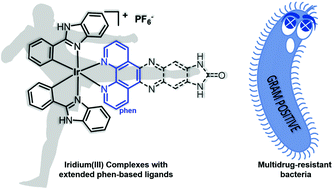Inert cationic iridium(iii) complexes with phenanthroline-based ligands: application in antimicrobial inactivation of multidrug-resistant bacterial strains†
Abstract
The antimicrobial activity of a new series of heteroleptic iridium(III) complexes of the type [Ir(C^N)2(N^N)][PF6] (C^N = deprotonated 2-phenylbenzimidazole-κN, κC; N^N = phen (Ir1), dpq (Ir2), dppz (Ir3), dppn (Ir4), and dppz-idzo (Ir5)) was studied towards two Gram positive (vancomycin-resistant Enterococcus faecium and a methicillin-resistant Staphylococcus aureus) and two Gram negative (Acinetobacter baumanii and Pseudomonas aeruginosa) multidrug-resistant bacterial strains of clinical interest. Although the complexes were inactive towards Gram negative bacteria, their effectiveness against Gram positive strains was remarkable, especially for Ir1 and Ir2, the most bactericidal complexes that were even more active (10 times) than the fluoroquinolone antibiotic norfloxacin and displayed no toxicity in human kidney cells (HEK293). Mechanistic studies revealed that the cell wall and membrane of MRSA S. aureus remained intact on treatment with these compounds and that DNA was not their main target. It is important to note that the complexes were able to induce ROS generation, this being the feature key to their antimicrobial activity.



 Please wait while we load your content...
Please wait while we load your content...